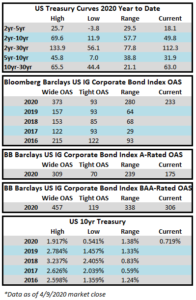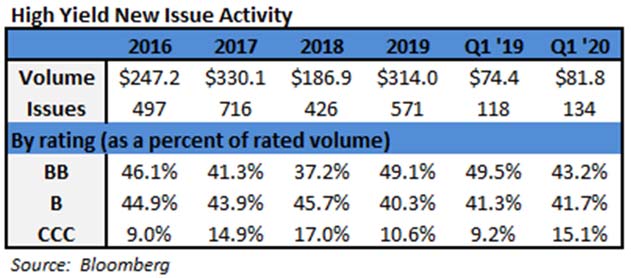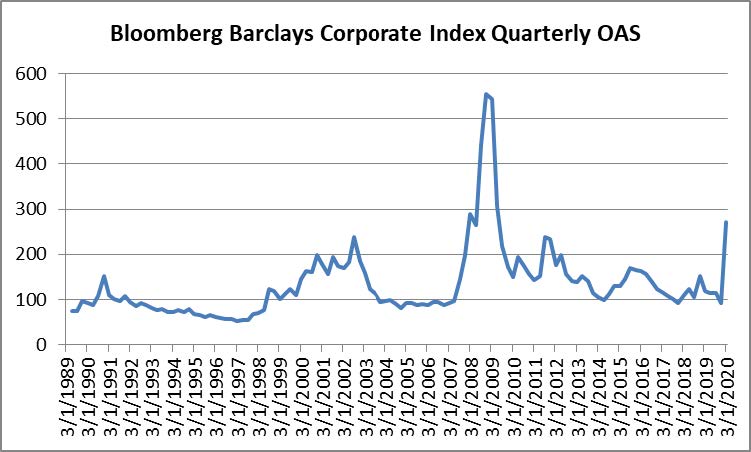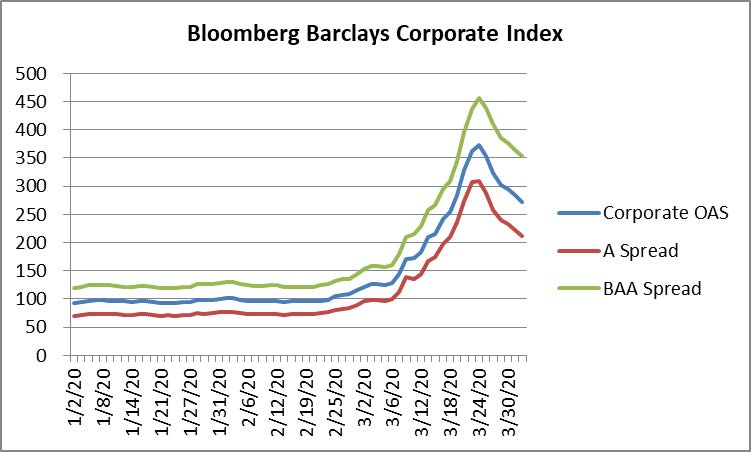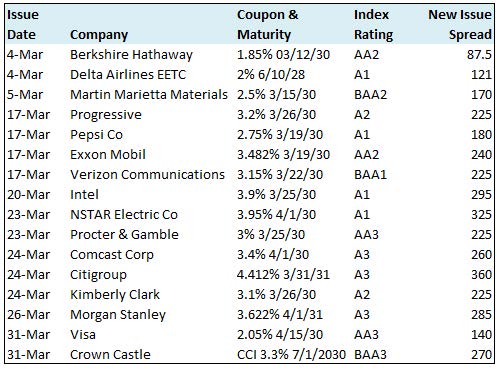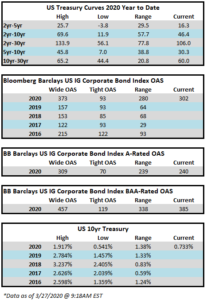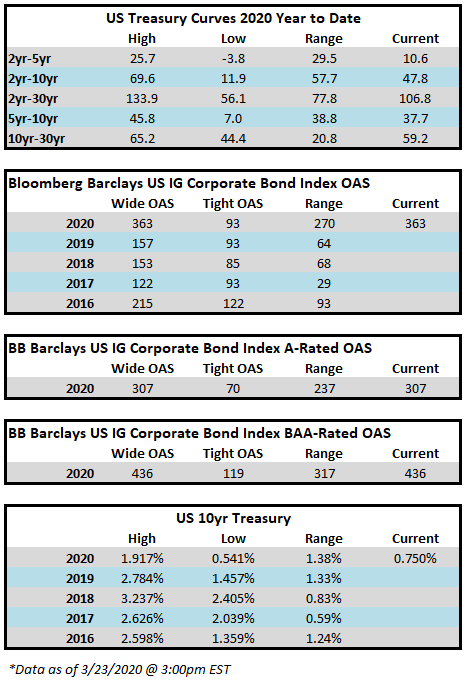Fund Flows & Issuance: According to a Wells Fargo report, flows week to date were +$2.9 billion and year to date flows stand at -$16.0 billion. New issuance for the week was $4.3 billion and year to date issuance is at $76.5 billion.
(Bloomberg) High Yield Market Highlights
- The robust demand for new issuance, coupled with continued fund inflows, has pushed junk bond spreads to a three-week low.
- Junk bonds have posted gains in seven of the last 10 sessions.
- Investors have been pouring cash into high-yield retail funds for the last three weeks
- Nordstrom increased the size of its debt offering by $100m to $600m after getting orders of more than $4b as junk investors sought higher- quality debt
- Nordstrom priced at par to yield 8.75% after talk tightened from 10% area to 9%-9.25%
- The retailer is still high grade, but fallen angels are expected to outperform high yield, according to Ashish Shah of Goldman Sachs Asset Management said
- This was the second investment-grade borrower to tap high-yield investors to increase liquidity by offering attractive coupon, following Carnival
- Elsewhere in primary, propane distributor Ferrellgas sold $575m 1st lien senior secured notes, rated B3/CAA, at par to yield 10%
- Tightened talk from 10.5%-11%
- Earlier in the week, Wynn raised $600m, up from $350m initially, through the sale of five-year notes and cut the coupon to 7.75% from around 8.5%
- Junk bond yields dropped to a three-week low of 8.48% while spreads tightened to +785, also a three-week low
- BA spreads narrowed to 535bps while yields dropped to 6.04%
- Single B yields fell to 8.42% and spreads fell to 779 bps
- CAA yields dropped to 16.82% and spreads tightened to 1,641bps
(Bloomberg) Fertitta’s Record Rate Stokes Surge in Demand for Leveraged Loan
- A record high interest rate on Tilman Fertitta’s loan sale seems to be doing to trick. Order books for the $250 million deal are at least double that just a day after it was launched, according to people familiar with the matter.
- The loan, which matures in October 2023, is being arranged by Jefferies Financial Group Inc. Based on initial discussions with investors, it’s being offered at a spread of 14 percentage points over the benchmark London interbank offered rate with a floor of 1% and at a discount of about 96 cents on the dollar.
- That makes the all-in yield at least 16%, according to calculations by Bloomberg. The spread is the highest ever seen in the U.S. leveraged loan market excluding companies in bankruptcy, according to data compiled by Bloomberg. That all-in yield may fall due to strong demand for the debt, the people said.
- The Texas billionaire is looking to raise the loan to keep his casino and restaurant empire afloat through year-end if the Covid-19 virus shutdown persists. The offering is ending a near one-month drought in the market for risky corporate loans, but the company will be saddled with excruciatingly high borrowing costs.
- To put those costs into more perspective, Fertitta’s Golden Nugget sold a $200 million loan in January that financed a dividend at just 2.5 percentage points over Libor. That loan, which also matures in 2023, has since dropped and is trading at about 75.5 cents on the dollar, according to data compiled by Bloomberg. That equates to a yield of almost 12%, and a premium of at least four percentage points for the new loan.
Update:
- Texas billionaire Tilman Fertitta has cut the interest rate on a $250 million leveraged loan sale to keep his restaurant and casino empire afloat and is considering boosting the size of the deal after being inundated with demand from investors.
- Potential lenders have submitted about $1.4 billion of orders for the debt, which pays an all-in yield of at least 14%, according to a person with knowledge of the matter. Fertitta is considering increasing the size of the loan to $300 million and will still contribute $50 million of his own cash into the company, the person said, asking not to be identified because the discussions are private.
- The loan is now being offered at a spread of 12 percentage points over the benchmark London interbank offered rate with a floor of 1% and at a discount of about 96 cents on the dollar, according to separate people familiar with the matter.
(Reuters) Global oil output cuts held hostage to standoff
- Oil producers in the OPEC+ group, led by Saudi Arabia and Russia, were expected to pressure Mexico on Friday to seal an accord for a collective cut in output of 10 million barrels per day, before asking other nations for a further 5 million bpd of cuts.
- The United States has encouraged global cooperation to bolster an oil market that collapsed as the coronavirus pandemic accelerated in March and producers resorted to a price war after failing to agree on how to prop up prices.
- Oil prices tumbled on Thursday despite OPEC+ nearing agreement as the lockdowns ordered across the world sucked life out of the global economy, and traders reckoned that even a combined reduction of 15 million bpd would be too little to stabilize the market.
(Bloomberg) Fed to Buy Junk Bonds, CLOs and Lend to States in New Stimulus
- The Federal Reserve on Thursday announced another series of sweeping steps to provide as much as $2.3 trillion in additional aid during the coronavirus pandemic, including starting programs to aid small and mid-sized businesses as well as state and local governments.
- In an unprecedented move, the Fed also said Thursday it would move to shore up some of the hardest-hit parts of financial markets, pledging to start buying some debt recently downgraded to below investment grade as well as certain collateralized loan obligations and commercial mortgage-backed securities.
- “Our country’s highest priority must be to address this public health crisis, providing care for the ill and limiting the further spread of the virus,” Fed Chair Jerome Powell said in a statement. “The Fed’s role is to provide as much relief and stability as we can during this period of constrained economic activity, and our actions today will help ensure that the eventual recovery is as vigorous as possible.”
- A Municipal Liquidity Facility will offer as much as $500 billion in lending to states and municipalities, by directly purchasing that amount of short-term notes from states as well as large counties and cities.
- The Main Street Lending Program will “ensure credit flows to small and mid-sized businesses with the purchase of up to $600 billion in loans.”
- Expanding the size and scope of the Primary and Secondary Market Corporate Credit Facilities and the Term Asset-Backed Securities Loan Facility to support as much as $850 billion in credit.
- Its Secondary Market facility may purchase U.S.-listed ETFs. While the preponderance of those holdings will be those primarily focused on U.S. investment-grade corporate bonds, the remainder will be in ETFs whose primary investment objective is exposure to U.S. high-yield corporate bonds.
- Starting the Paycheck Protection Program Liquidity Facility, “supplying liquidity to participating financial institutions through term financing backed by PPP loans to small businesses.”
